Sierra Designs Backcountry Bed 700 20 Men's
-

 CampSaver.com
CampSaver.com$299.95$209.95See it -
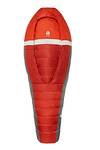
 Amazon US$319.95See it
Amazon US$319.95See itAmazon.com Price: $319.95 (as of 10/24/2024 20:18 PDT) Details
Product prices and availability are accurate as of the date/time indicated and are subject to change. Any price and availability information displayed on Amazon.com at the time of purchase will apply to the purchase of this product.
Sierra Designs Backcountry Bed 700 15 Women's
-

 CampSaver.com
CampSaver.com$479.95$329.95See it -

 Amazon US$479.95See it
Amazon US$479.95See itAmazon.com Price: $479.95 (as of 10/22/2024 14:01 PDT) Details
Product prices and availability are accurate as of the date/time indicated and are subject to change. Any price and availability information displayed on Amazon.com at the time of purchase will apply to the purchase of this product.
Sierra Designs Backcountry Bed 700 35 Men's
Sierra Designs Backcountry Bed Overview
The Sierra Designs Backcountry Bed represents a bold and creative step in the search for perfect wilderness slumber.
Remember when sleeping bags were nylon and flannel behemoths that had to be transported by mule? Well, we’ve come a long way baby. Sleeping bags are lighter, smaller, warmer, and more sturdy than ever before — and Sierra Designs is a tried and true brand that’s helping to lead the charge.
Sierra Designs decided to do away with what is most common in sleeping bags: zippers, a normal enclosure, and a closed footbox. That’s right folks. You heard it here first. A sleeping bag doesn’t need a zipper, and may actually be better without one.
While this is an excellent sleeping bag, our Classic Pick for Wilderness Backpackers remains the REI Igneo 17 (and the women’s Joule). The Igneo is lighter for a bag that’s as warm, is a little bit cheaper, and works like a normal sleeping bag. If you want a more innovative bag, hate sleeping in mummy bags, or really want an integrated sleep system, we do recommend the Backcountry Bed over the Igneo.
If you know my reviews, I always include a dashingly clever pun about the piece of gear I’m reviewing at this point, so I think I will surprise everyone and simply invite you to peruse our comprehensive sleeping bag guide. It has more information than you can imagine, and will you get you into the warmest, comfiest version of an outdoor bed.
Below, read on for the full Sierra Designs Backcountry Bed review!
Sierra Designs Backcountry Bed Star Rating
- Comfort
- Warmth
- Durability
- Fit
Summary
The Sierra Designs Backcountry Bed is all about the comfort of your home bed with the specs of a high-end backpacking bag. Couple the design innovations with the built-in sleeping pad sleeve and you’re pretty much there.
Sierra Designs Backcountry Bed Specifications
| Feature Type | Feature Specs | What This Means |
|---|---|---|
| Weight | 2 lbs 8 oz. (1.14 kg) | A lightweight down sleeping bag. Not the lightest on the market for a rating of roughly 20 degrees, but decent. |
| Type | Unique Bed | The Backcountry Bed is unlike other bags. It has a general mummy shape around the torso and feet, getting close around the footbox, but the chest area has a large opening and bed-like comforter. The hood is like a mummy as well. For more info on the types of sleeping bags, and how they compare to quilts, read our guide. |
| Size | Regular, 6 ft. (183 cm) | Standard size for a sleeping bag. Sierra Designs offers this in a Long for men, and a smaller size (5’8″) for women. |
| EN Rating | EN Limit: 16 F (-9 C), EN Comfort: 28 F (-2 C) | This bag has been EN Tested, and is plenty comfortable at 28 F, just below freezing. You should be able to survive at 16 F, though it might get chilly around then. Our tests show excellent warmth. Read more about how temperature ratings are determined in our guide. |
| Insulation Type | 700-Fill Power PFC-Free Dridown | Mid-range fill down with a hydrophobic treatment that keeps the down from getting soaked, and increases the speed that it will dry out. THe move to PFC-free down is excellent. Read more about sleeping bag insulation in our Guide. |
| Fill Weight | 22.4 oz (634 g) | A little over half this bag is down, which is solid. The extra weight is in shell fabric and the extra large comforter. |
| Shell Fabric | 20D Polyester Ripstop | A medium thickness fabric that is quite durable. Read more on sleeping bag and quilt shell fabric material in our Guide. |
| Lining Fabric | 20D Polyester Taffeta | A medium thickness fabric that is quite durable |
| Sleeping Pad Sleeve | Fits 20 x 2.5 in. | Not all bags have this, but the Backcountry Bed does. A sleeping pad sleeve is attached to this bag so you can slip in a pad and stay there all night. Has size limitations, but works with industry standard pads. |
| Water Resistant? | Yes | The hydrophobic down is more water resistant than regular down. |
| Baffle Pattern | Horizontal | Standard horizontal baffles on a pad. Read more on sleeping bag and quilt baffle patterns in our Guide. |
| Zipper | No Zipper | No zippers at all! A giant leap forward in design, as zippers let in air, weigh a decent amount, and break. |
| Draft Tube? | N/A | No zipper means no draft tube, and no place for air to leak in. |
| Neck Baffle? | No | There is not a neck baffle in this bag, but it does have a large comforter in the front. |
| Pocket? | No | Made for lightweight backpacking means no pockets. |
| Manufacturer Warranty | Limited Lifetime Warranty | Sierra Designs warranties its products for life. If something malfunctions be sure to get in touch. That said, with no zippers, there’s a lot less to malfunction. |
| Retail Price | $319.95 | A high price for a quality down bag that has a ton of unique features. |
Gear Review of the Sierra Designs Backcountry Bed
Origins: Easing You In
If you have become a Backpackers.com aficionado, you may automatically associate my name with sleep systems. For some reason they keep throwing these incredible quilts and sleeping bags at me and asking me to test them and write about the experience. It’s a terrible burden, but someone has to do it! Given how unique the Sierra Designs Backcountry Bed is I really wanted to put it through its paces.
First, I took it on an overnight kayak trip to Emerald Bay in South Lake Tahoe over the summer. Next, I stuffed it in my pack for an autumn backpacking trip to Kings Canyon, attempting to escape the Northern California wildfires. Lastly, I slept outside my friend’s cabin in Soda Springs in snowy, frigid conditions.
Yup, I take my testing seriously!
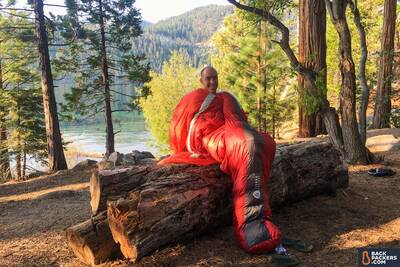
Taking the Sierra Designs Backcountry Bed testing very seriously.
Revelation: The Moment I Knew
We made our way across Lake Tahoe in a lazy zig zag toward Emerald Bay, occasionally dodging a speed boat or runaway jet ski. When we turned the corner and got our first view of the bay — with Fannette Island rising from its belly like a great, stone kraken — it was hard to remember that civilization surrounded us. It was still warm when we beached our kayaks, but I immediately opened my storage compartments to set up camp.

Compressible sleeping bags in waterproof sacks via kayak is clearly the way to arrive at camp.
There isn’t an impressive amount of storage space in my touring kayak, so I appreciated the extreme packability of the Sierra Designs Backcountry Bed as I extricated it from my boat. Kayak or backpack, it’ll fit.
Later that night when the temperature failed to drop as expected, I fell in love with the bag. It was 55 degrees out, I sleep hot, and I was in a sleeping bag rated that had an EN Limit rating of 16 F. That could have been one sweaty mess of a night.
But, the Backcountry Bed has this super cool top comforter that can be used as a blanket when it’s warm out, or tucked into the bag for colder temperatures. You better believe I used it as a blanket. And slept like a baby.
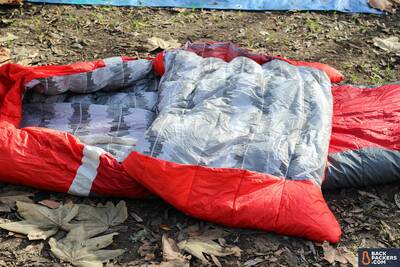
The “Bed” in Backcountry Bed is a comforter-like top that can be opened to let out heat, or bundled up to keep it in.
Digging Deeper
There are bunch of other sweet features that tickled the gear geek inside of me over the next two trips. First of all, having no zipper is mind blowing. How many times have you tried to use the zipper in the darkness of night and managed to get it snagged? Plus, over the years I’ve broken zippers, woken up with zipper marks on my face from sleeping on them, and even padded zippers with extra clothing to keep the cold out. Zippers suck.
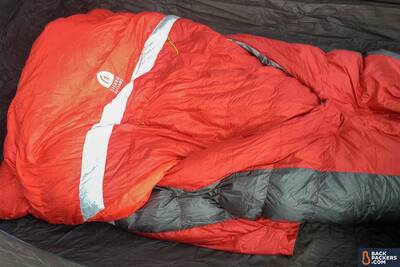
No zippers to speak of.
Sierra Designs has crafted the Backcountry Bed to be comfortable and snug without one. It’s a brave new world my friends. Because the comforter is so large, it allows for easy entry and exit of the bag, and does away with sliding in from one side.
The second “bed”-like feature of the Backcountry Bed is a sleeping pad sleeve, which allows you to create an integrated sleep system that moves with you during the night. This is huge, and so genius! You may have a rocking bag, and a rocking pad, yet still find yourself sleeping on the floor of your tent because you keep slipping off. The pad sleeve keeps your warmth tied to your comfort, making for a true bed-like rest.
The sleeve only fits pads up to 20 inches (which is the industry standard for most sleeping pads), but even with that limitation it’s a fantastic feature that works as advertised. It left me wondering: Why didn’t I think of that?
Something else I adore about the Backcountry Bed are the hand pouches at the top. I have written about this feature in my review of the Sierra Designs Backcountry Quilt, and I love it just as much as I did then. The hand pouches keep your hands toasty even if you’re an arm-over-the-head-sleeper. More importantly, they serve as invaluable guide posts during the night when trying to figure out where you are in your bag. This may be my favorite feature of all time.
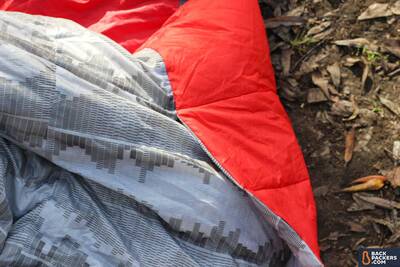
Hard to conceptualize here, but this is a hand/arm sleeve in the top of the comforter. Excellent for navigation, warmth, and cuddling yourself.
Finally, with its sleek, zipperless body and top comforter the bag looks like something futuristic that the Predator may have brought with him from Yautja-Prime (aliens gotta sleep too). Big bonus points in my book.
Comfort 4 Stars
Roomy, warm, soft, and cozy as a nun’s cocker spaniel (don’t ask). The ability to slip your sleeping pad into the bottom sleeve to create an integrated sleep system is brilliant and makes a pleasantly unexpected difference, and the comforter really does feel like you’re sleeping in a bed at home. Also, more comfortable than a normal sleeping bag because of the zipperless design.
I’m docking one point due to the hole near the feet. I didn’t find this useful, and it actually confused my generally restful experience throughout the night. The comforter works so well that you can adjust temperature that way — this was just too much.
Warmth 5 Stars
I was very impressed. I tested this bag in 24 F, on snow, with a real feel in the teens, and I was cozy. Generally when it’s that cold it takes awhile to warm up once entering the bag, but I was agreeably heated within minutes. I was using a Therm-a-Rest NeoAir XLite and wearing light thermals and a beanie — but this is my standard testing set up.
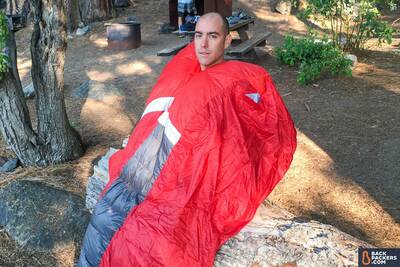
Posing for warmth.
Note that this warmth is dependent on a solid sleeping pad with a reasonable R Value for your climate, which is true of all sleeping bags.
Plus with the comforter the warmth is fairly adjustable — no overheating on a 55 degree night — which does more than most bags.
Durability 5 Stars
I’ve used this bag three times, in three different ways. It’s been stuffed in a kayak and backpack; wet and on snow. Zero issues. I think the zipperless design is inherently more durable as well. I also know from experience that Sierra Designs tends to make products that last.
Fit 5 Stars
Extremely comfortable bag. I’m 5’9”, 155 with broad shoulders and had room to move around and sleep on my side, back, and stomach in the medium bag. I also occasionally had my arms above my head and the hand pouches kept my hands and arms warm. I felt more like I was in my bed at home than in a sleeping bag. Big props.
The bag is offered in a long, too, and in a women’s version, which is smaller than the medium or long, so you should be able to find one that fits.
Grievances
As much as I appreciate the Sierra Designs Backcountry Bed (and I do, very much) there are a few fairly significant issues I encountered.
Foot hole — one feature too many
The bottom of the bag has an overlapping hole that you can stick your feet out of on warm nights. Cool idea, but, for me, swing and a miss. I found it cumbersome and not very useful, and it bothered me (if only philosophically) when it got really cold.
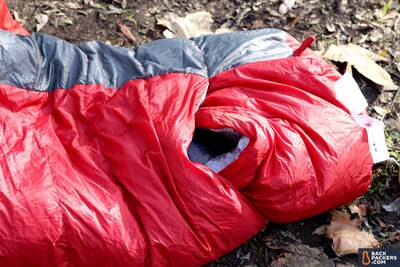
This hole at the bottom of the Backcountry Bed felt unnecessary, and a little weird. Your feet might get tangled up in accidentally, and it’s not super necessary for letting out more heat, because you can do that up top.
Call me old school, but I don’t like the idea of holes in my sleeping bag. I also didn’t really know what it was or how to use it until I watched a video about the bag, which leads me to my next disclaimer…
Complicated
It’s awesome that Sierra Designs is thinking outside of the box when designing new bags, but those innovations create a learning curve. This is not a throw and go sleeping bag. In fact one of the reasons I tested it three times is because I failed to understand or properly use all the features the first time. I strongly suggest reading about the bag (like this review!), and/or watching a YouTube video about it before heading into the wilderness.
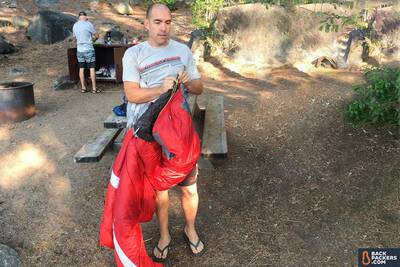
The look of someone who has to figure out their sleeping bag. Know before you go!
Not the lightest option
If you’re looking for a solid bag that will keep you warm and comfortable, this bag is hard to beat. But if you’re an ultralight enthusiast that allocates 3 sheets of toilet paper per day and cuts your toothbrush in half, this may not be the bag for you. It’s light (2 pounds 8 ounces), but not the lightest option on the market.
Final Word
The Sierra Designs Backcountry Bed is a very cool sleeping bag with a couple revolutionary features. I admire companies that constantly iterate and improve – and the Backcountry Bed does so with bravery and impressive ingenuity.
Where to Buy Sierra Designs Backcountry Bed
We tested the men’s Regular Sierra Designs Backcountry Bed 700 20 Degree, which is the full name. This bag is offered in a Long as well. The women’s version is roughly the same, but is called the Backcountry Bed 600 15 Degree, adding more warmth because women often run colder, and is a little shorter than the men’s bags.
The men’s line is also offered in a 35 degree bag, called the Backcountry Bed 700 35 Degree.
Compare Sierra Designs Backcountry Bed prices below.
Sierra Designs Backcountry Bed 700 20 Men's
-

 CampSaver.com
CampSaver.com$299.95$209.95See it -

 Amazon US$319.95See it
Amazon US$319.95See itAmazon.com Price: $319.95 (as of 10/24/2024 20:18 PDT) Details
Product prices and availability are accurate as of the date/time indicated and are subject to change. Any price and availability information displayed on Amazon.com at the time of purchase will apply to the purchase of this product.
Sierra Designs Backcountry Bed 700 15 Women's
-

 CampSaver.com
CampSaver.com$479.95$329.95See it -

 Amazon US$479.95See it
Amazon US$479.95See itAmazon.com Price: $479.95 (as of 10/22/2024 14:01 PDT) Details
Product prices and availability are accurate as of the date/time indicated and are subject to change. Any price and availability information displayed on Amazon.com at the time of purchase will apply to the purchase of this product.
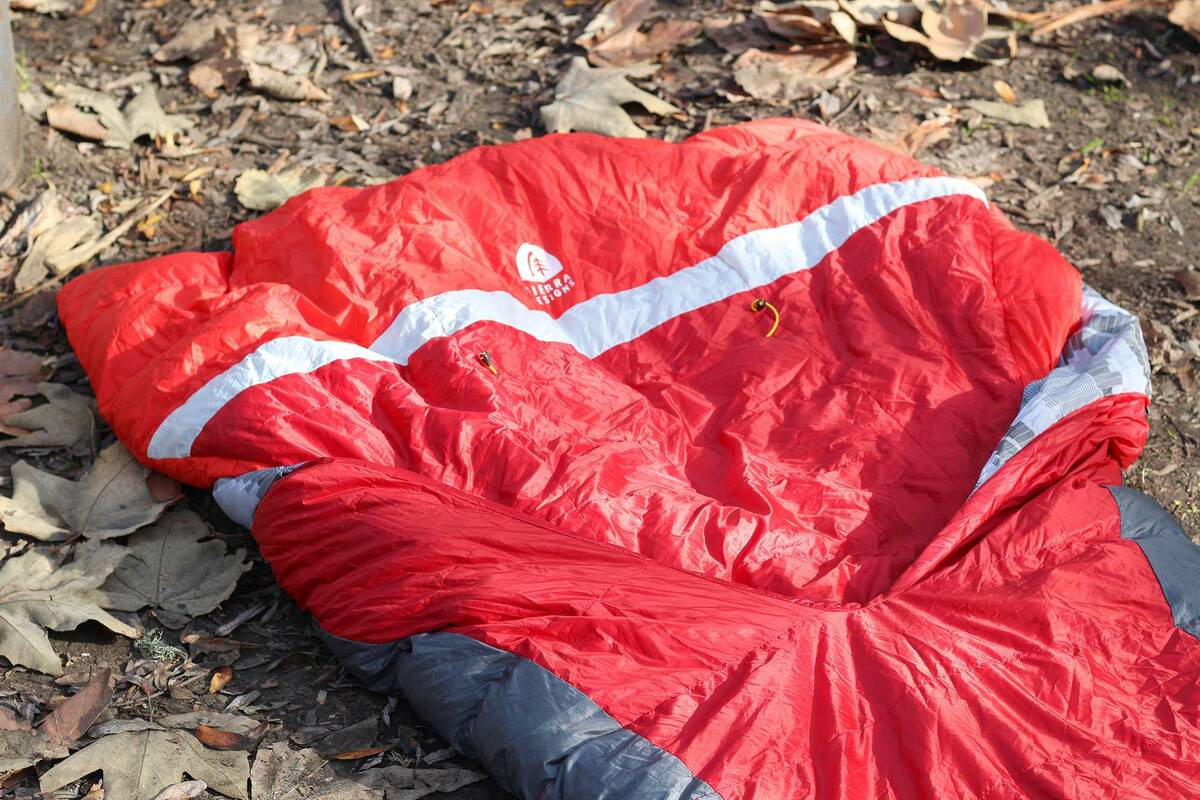
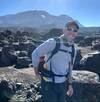
One of the best reviews I’ve read
Just spotted these bags on Google
Looking for a summer autumn bag uk
Seam to fit the bill
Thanks Tony
Thanks Tony! We’re big fans of the Backcountry Bed, especially if you’re sick of mummy bags.
Happy camping!